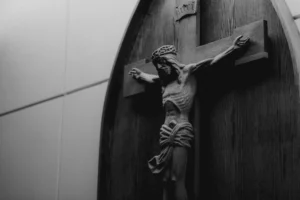I love looking at old photos. I try to imagine what was going through people’s heads as they posed for photos 25 years ago, 50 years ago, a hundred years ago.
So imagine the thoughts that went through my head when I came upon a collection of photos posted on the Web site of U.S. Holocaust Memorial Museum. This photo album once belonged to a Nazi officer named Karl Hoecker, a member of Hitler’s SS and adjutant to the commander of the Auschwitz death camp. (The photo album was recently donated to the museum by an American who found it in an abandoned building at the end of the war.)
The photos are revealing mostly for what they don’t show. No sign of these men’s (and women’s!) primary occupation: the killing and disposing of tens of thousands of Jews. No, these photos show Hoecker and his comrades relaxing at a vacation lodge that was nestled in the woods near Auschwitz. Sunning themselves on deck chairs. Laughing when caught by a surprise cloudburst. Preparing to go hunting or, more bizarre (and sickening), lighting a Christmas tree as they prepare to celebrate the birth of our Savior.
What were they thinking? Did they have any idea what was going on within a mile or so of their little vacation retreat? Of course they did. After all, the SS Death’s Head emblem affixed to their uniforms was surely a reminder of their primary business.
It’s easy to think of the Nazis as raving madmen. About our only film footage of Hitler shows him in full rant while speaking to a rally of the faithful. It’s easy to think that what happened in Germany was an aberration, an entire society fallen victim to a one-of-a-kind monster who bamboozled them with his rhetoric. That’s why I appreciated the film Downfall. (It’s in German with English subtitles.) Actor Bruno Ganz studied rare footage and voice recordings of Hitler and, in a stunning performance, captures the real man: the boss who was kind to his secretary, who loved dogs and children, who was often ready to give the benefit of the doubt to the lowly. It makes what Hitler did all the more scary: a pretty ordinary guy in most circumstances was allowed to give full vent to his penchant for evil with the help of an entire nation.
Or watch Conspiracy, a chilling portrayal of the conference where the Nazis formulated their “final solution” for the Jews, all chaired with über-efficiency and politesse by Adolf Eichman, the man for whom Hannah Arendt coined the phrase “the banality of evil.”
The photos of SS adjutant Hoecker and his friends show people behaving in perfectly ordinary ways while great horrors took place, under their supervision, on just the other side of the trees. I ask myself, What were they thinking!? in more ways than one.
I often wonder what I would have done had I been a young man in Nazi Germany. Would I have been laughing alongside those SS officers in Hoecker’s photo album? The fact that I can’t readily answer that question scares me. Scripture tells us, “The heart is deceitful above all things, and desperately wicked: who can know it?” (Jeremiah 17:9). The job of civilization is to temper that wickedness. Unfortunately, civilization often fails or, all too often, readily joins in the evil.
That’s why it’s important never to become sentimental about our fellow man as did men like Jean-Jacques Rousseau. His sentimentalism vs. clear-headed realism contributed to another great evil — the French Revolution.
We are to love our fellow man as our Lord loves him, but we must also be aware that, given free rein, he is capable of great evil. We can never let down our guard. Otherwise, we might find ourselves and our society in photos terribly similar to those in Herr Hoecker’s album.










